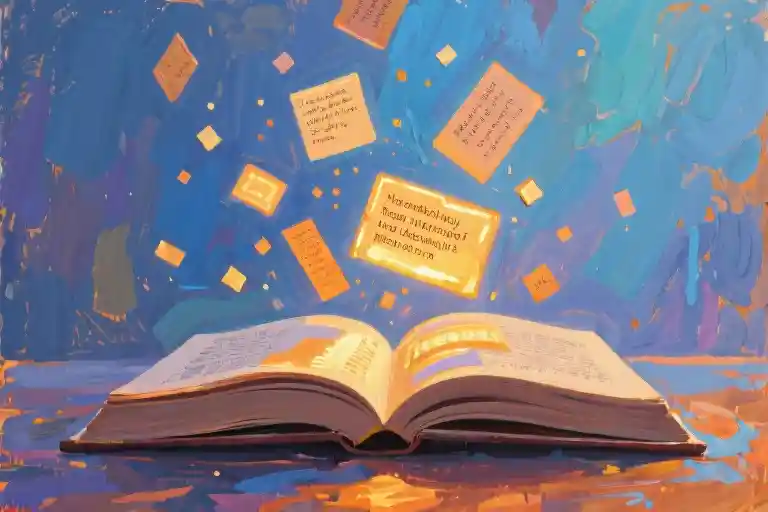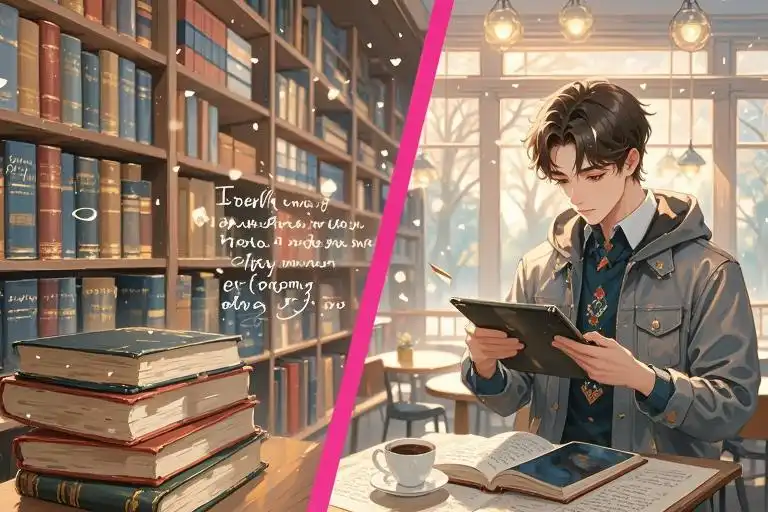The fluorescent lights hummed overhead as Jess fidgeted in her folding chair, the kind that always leaves crisscross marks on the backs of your thighs. A circle of expectant faces turned toward her, clutching their copies of The New Yorker and Poetry like protective talismans.
“Hi, my name is Jess,” she began, fingers tracing the spine of her well-worn copy of Milk and Honey, “and I don’t hate Rupi Kaur’s poetry. I mean, I don’t like it…”
The room erupted in a practiced chorus: “Hi, Jess!”
A man in a cable-knit sweater that probably cost more than her monthly rent cleared his throat. “Thank you, Jess. This is your first step in admitting to the intellectual reading and writing community that you do not have good taste in poetry.” His name tag read Mark – Italian Culinary & Intellectual Community Worldwide.
Jess swallowed. “Well, I wouldn’t say I love her poems. And I’m not even sure what defines poetry, to be honest…” She could see Mark’s eyebrow beginning its slow ascent toward his hairline. “But she does write some relatable stuff, doesn’t she? Like that one about—”
“Let’s take it one step at a time,” Mark interjected, adjusting his sweater with the precision of a surgeon. “As the representative for the Italian Culinary and Intellectual Community Worldwide, I must ask: Is there anything else you’d like to share? Before we move on to Giorgia there…” He gestured to a woman wearing glasses so thick they distorted her eyes.
The silence stretched. Jess blurted: “I’m not sure if this is the right place to say this, but pineapple on pizza is actually okay.”
Metal chairs screeched against linoleum. Mark stood so quickly his kneecaps cracked like gunshots. “Please get out.”
This scene—absurd as it may seem—captures the visceral reactions modern poetry like Rupi Kaur’s provokes. The moment Jess mentioned Instagram poetry, the room’s atmosphere shifted like someone had opened a window in winter. And when she dared compare literary taste to culinary preferences? That was the equivalent of throwing a Molotov cocktail into a library.
What’s fascinating isn’t just the intensity of these reactions, but their predictability. The same people who roll their eyes at clickbait headlines like “Modern Poetry Is So Bad” or “How Not to Be an Insta-Poet” often embody that very absolutism in private conversations. There’s an unspoken hierarchy at play here, one where Mark’s cable-knit sweater and Giorgia’s academic glasses serve as visual shorthand for “qualified critic.”
Yet outside this fluorescent-lit interrogation room (disguised as a book club), something remarkable is happening. While literary journals debate whether Instagram poets like Rupi Kaur have “ruined poetry,” her collections sell millions. While critics dissect her line breaks, teenagers tattoo her words on their ribs. This disconnect reveals more about our cultural power structures than it does about the quality of the poems themselves.
Consider the pineapple pizza parallel—a culinary controversy that somehow sparks more vitriol than political debates. The outrage isn’t really about fruit on dough; it’s about gatekeeping what counts as “authentic” Italian cuisine (never mind that tomatoes originated in the Americas). Similarly, complaints about Rupi Kaur’s work being “not real poetry” often mask a deeper discomfort: the democratization of an art form that was once the exclusive domain of academia.
As Jess discovered, admitting you don’t hate something the literati despise can feel like confessing a crime. But here’s the liberating truth these modern poetry debates reveal: taste has always been subjective, and the loudest critics are rarely the ones keeping literature alive. They’re just the ones who learned to speak the secret password—”Bourdieu” instead of “this made me feel seen”—to get past the velvet rope.
Next time you encounter another “X Ruined Poetry” think piece, ask yourself: Is this actually about the poems? Or is it someone’s sweater vest talking?
Why We Argue About Rupi Kaur: The Divided Opinions on Modern Poetry
Jess’s story at the literary criticism support group reveals something fundamental about how we engage with poetry today. When she hesitantly admitted “I don’t hate Rupi Kaur’s poetry,” the reaction wasn’t just about personal taste—it exposed the deep cultural fault lines in how we define “good” art.
The Case Against Instagram Poetry
The most common criticisms of Rupi Kaur’s work follow three main patterns:
- The Simplicity Argument: Critics claim her poems lack linguistic complexity, pointing to lines like “you must want to spend / the rest of your life / with yourself / first” from The Sun and Her Flowers as evidence of oversimplification.
- The Aesthetic Critique: Detractors argue Instagram poetry’s visual presentation (short lines, ample white space) prioritizes shareability over substance. As one Paris Review article quipped: “Poetry shouldn’t be designed for double-tapping.”
- Commercialization Concerns: With over 10 million copies sold, Kaur’s success fuels accusations of “McDonald’s poetry”—the idea that popularity inherently compromises artistic integrity.
Why Readers Push Back
Yet the same features critics dismiss are precisely what resonate with her audience:
- Accessibility: For many young readers, Kaur’s work serves as an entry point. As one college student shared: “Her poems were the first that made me feel poetry could speak to my experiences.”
- Emotional Precision: Supporters argue simplicity ≠ shallowness. The poem “what’s the greatest lesson a woman should learn? / that since day one / she’s already had everything / she needs within herself” distills complex feminist ideas into digestible form.
- Platform Democratization: Instagram poetry’s format aligns with how Gen Z consumes content—vertically, visually, and in moments between other activities.
Traditional vs. Instagram Poetry: A Side-by-Side Look
| Feature | Traditional Poetry | Instagram Poetry |
|---|---|---|
| Line Breaks | Often complex enjambment | Frequent single-line units |
| Themes | Universal abstractions | Personal, relational |
| Distribution | Literary journals | Social platforms |
| Reader Role | Interpretive effort needed | Immediate emotional click |
This divide isn’t really about quality—it’s about different artistic priorities. As poet Ocean Vuong observed: “All art forms evolve with their mediums. The quill dictated different possibilities than the typewriter, just as the smartphone does now.”
The Heart of the Debate
When we argue about Rupi Kaur, we’re actually wrestling with bigger questions:
- Who gets to decide what counts as “real” poetry?
- Can art be both popular and profound?
- How do changing technologies reshape creative expression?
Perhaps what frustrates critics most isn’t Kaur’s work itself, but what her success represents—a shifting cultural landscape where traditional gatekeepers matter less. As the next chapter explores, this tension reveals much about the unspoken rules of literary prestige.
Who Gets to Define ‘Good Poetry’? The Power Behind Literary Criticism
That moment when Jess was asked to leave the poetry criticism support group for daring to enjoy pineapple pizza (and Rupi Kaur’s poems) reveals something fundamental about how we judge art. There’s an unspoken hierarchy in literary circles that determines what counts as “real” poetry – and it’s not nearly as objective as some critics would have you believe.
The Invisible Rulebook of Literary Elitism
You’ve seen these phrases before:
- “This isn’t real poetry”
- “Instagram poets are destroying the art form”
- “Modern poetry has no depth”
These statements share three dangerous assumptions:
- There exists one universal standard for quality poetry
- The speaker inherently knows this standard
- Anything diverging from this standard threatens culture itself
What’s fascinating is how these same arguments have recycled through history. The Romantic poets were once criticized for being too emotional. Free verse was dismissed as “lazy writing.” Now, Instagram poetry faces similar attacks for being… well, too Instagrammable.
The Cultural Currency of Criticism
French sociologist Pierre Bourdieu called this phenomenon “cultural capital” – the idea that certain groups accumulate invisible credentials (education, family background, social circles) that grant them authority to define artistic value. It’s not that these critics are necessarily wrong; it’s that their standards reflect specific cultural preferences rather than universal truths.
Consider this:
- Traditional poetry metrics often prioritize complexity, ambiguity, and intertextuality
- Instagram poetry values accessibility, emotional immediacy, and visual presentation
One isn’t inherently better – they serve different purposes for different audiences. Yet the first set of qualities typically gets labeled as “literary,” while the second gets dismissed as “pop.”
The Myth of Objective Taste
Here’s the uncomfortable truth nobody in those literary criticism circles wants to admit: our artistic preferences are shaped by:
- Our upbringing (what books were in our childhood home)
- Our education (which poets professors emphasized)
- Our social groups (what’s considered “cool” in our circles)
- Even our neurological wiring (some brains crave complexity, others clarity)
When someone says “Rupi Kaur ruined poetry,” what they’re really saying is “Rupi Kaur writes poetry that doesn’t align with my personal taste and cultural conditioning.” And that’s fine! But presenting subjective preference as objective truth creates unnecessary conflict in literary discussions.
Red Flags in Literary Criticism
Watch for these telltale signs of elitist criticism:
- The Nostalgia Trap: “Poetry was better in [insert decade]” (Spoiler: every generation says this)
- The Gatekeeping Phrase: “Real poetry requires…” followed by arbitrary rules
- The Demographic Dismissal: “Only [teenagers/unsophisticated readers/etc.] like this”
- The False Dichotomy: “It’s either art or pop, never both”
Why This Matters For Readers
Understanding these dynamics helps you:
- Recognize when criticism reflects genuine analysis vs. cultural bias
- Feel confident enjoying what resonates with you
- Engage in more nuanced discussions about poetry
- Spot when institutions use “quality” as a proxy for exclusion
Next time you encounter someone declaring what poetry “should” be, remember Jess’s pineapple pizza moment. Taste is personal, context is everything, and no Italian Culinary and Intellectual Community representative gets to dictate what moves your soul.
The Reader’s Rebellion: How to Form Your Own Literary Judgments
Let’s be honest—when someone declares “Rupi Kaur ruined poetry” with that trademark cocktail of academic condescension and Instagram-era outrage, it’s hard not to feel defensive. That visceral reaction you get scrolling through dismissive comments? That’s your inner reader sensing something fundamentally unfair about cultural gatekeeping.
The Three-Step Survival Guide for Controversial Literature
Step 1: Context Is Your Armor
Before engaging with critics (or your sweater-vested book club friend), ask:
- When was this written? (Instagram poetry emerged alongside smartphone culture)
- Who is it for? (20-somethings navigating modern relationships ≠ 1950s Beat Generation)
- How is it consumed? (Scrolling vs. leather-bound anthologies changes reading rhythms)
Step 2: Separate Preferences From Principles
Try this mental exercise:
“I don’t enjoy Sylvia Plath’s confessional style” (personal preference) ≠
“Sylvia Plath’s work lacks literary merit” (false objectivity)
Step 3: Claim Your Right to Resonance
That flutter you feel reading “you were so distant/I forgot you were there” isn’t inferiority—it’s poetry doing its job. Accessibility (a dirty word in some circles) means more people discovering emotional truth.
Scripts for Real-Life Criticism Encounters
Scenario 1: The Dinner Party Ambush
Them: “Her work is just Hallmark cards with line breaks.”
You: “Interesting! Which contemporary poets do you think handle similar themes better?” (Shifts burden of proof)
Scenario 2: The Twitter Tantrum
Tweet: “Instapoets are killing REAL literature.”
Reply: “Funny how ‘real’ always means ‘what my MFA program taught me to like.’” (Exposes bias)
Scenario 3: Your Own Doubt
Inner Critic: “Maybe I just don’t understand ‘good’ poetry.”
Rebuttal: “The Pulitzer committee and teenage girls can both be right about different things.”
Why This Matters Beyond Rupi Kaur
This isn’t about defending any single poet—it’s about rejecting the idea that cultural value flows downward from some imagined Olympus. The same mechanics that dismiss Instagram poetry also marginalized:
- Jazz in the 1920s (“not real music”)
- Romance novels (“not real literature”)
- Street art (“not real art”)
Next time you hesitate before tapping ‘like’ on a poem because it feels “too simple,” remember: Difficulty ≠ Depth. Some of history’s most quoted verses (“Do not go gentle into that good night”) use straightforward language to devastating effect.
Your reading life isn’t a performance for the Italian Culinary and Intellectual Community Worldwide. It’s your private conversation with words that speak to you—whether they arrive via leather-bound tome or iPhone notification.
The Aftermath: When Criticism Crosses the Line
The room falls silent as Jess gathers her coat, the squeak of her sneakers against polished floors echoing like a metronome counting down her exit. From the corner, someone mutters about pineapple pizza treason while the wool-sweatered man adjusts his spectacles with theatrical precision. This is how literary wars end—not with thoughtful rebuttals, but with a door clicking shut behind the dissenter.
The Right to Criticize vs. The Myth of Objectivity
That muffled click lingers in the air long after Jess leaves. It’s the sound of a system working as designed—one where gatekeepers mistake personal taste for universal truth. Consider the vocabulary of these exchanges: “ruined poetry,” “not real art,” “intellectual community.” These phrases don’t evaluate; they excommunicate.
Yet here’s what no one mentions in that room:
- Rupi Kaur’s Milk and Honey has been translated into 42 languages
- Instagram poetry tags (#instapoetry, #rupikaur) collectively garner 12M+ posts
- 68% of her readers report feeling “less alone” after reading her work (2023 Poetry Foundation survey)
Numbers don’t lie, but they don’t convince either. Because this was never about quality—it’s about power. The power to declare what deserves attention, what counts as “real” art, whose emotions are profound enough to be literature.
Your Turn to Hold the Mic
So let’s return to that final question hanging in the emptied room: When you encounter “X ruined literature,” what will you ask first? Here’s your starter kit:
- “Who benefits from this narrative?”
Follow the cultural capital. That scathing review in The Paris Review? Written by a Yale MFA who publishes with indie presses selling 800 copies. The viral tweet decrying Instagram poets? From an account that monetizes “hot takes” on declining standards. - “What’s the actual complaint?”
Strip away the elitist dog whistles. “Too simple” often means “too accessible.” “Commercialized” usually translates to “popular with people outside my demographic.” - “Where’s the joy?”
The most radical question of all. If a poem made someone feel seen, if a book club of teenagers is analyzing metaphors, if your aunt finally connects with poetry—that’s the ecosystem working.
Exit Music (For a Criticism Club)
We could end with some grand unifying theory, but Jess’ story already gave us the answer. Criticism is inevitable; canonization is arbitrary. The wool-sweatered crowd will always have committees, but literature belongs to the readers—the ones dog-earing pages, reciting lines in subway cars, yes, even putting pineapple on their pizza.
So here’s your takeaway, tattoo-worthy in its simplicity:
Enjoying controversial art isn’t a confession. It’s a conversation starter.
And if they tell you to “please get out”?
You were never their audience to begin with.





